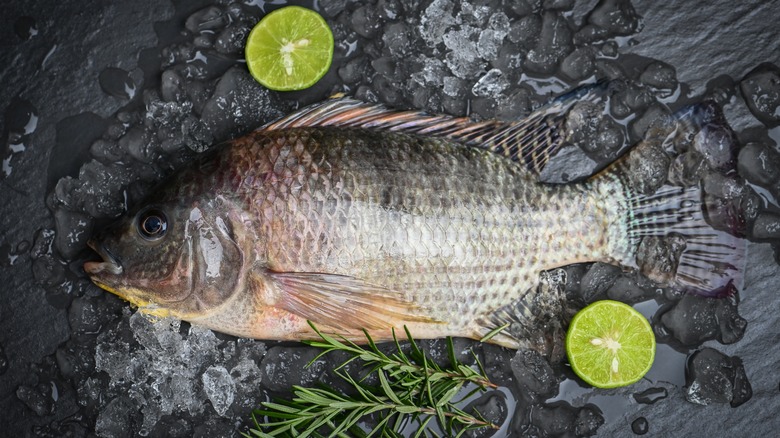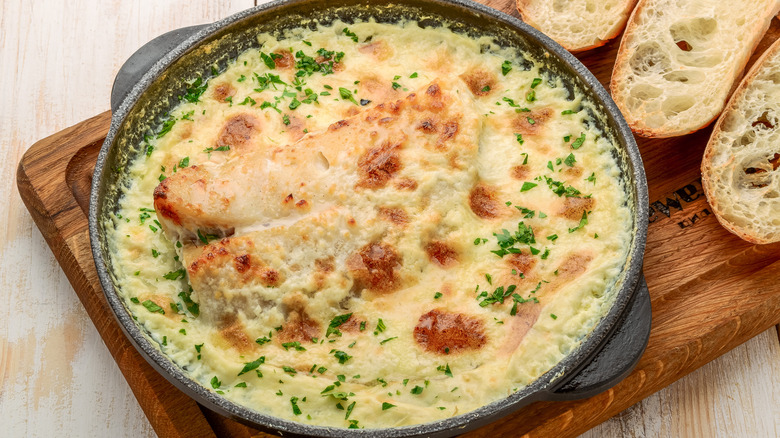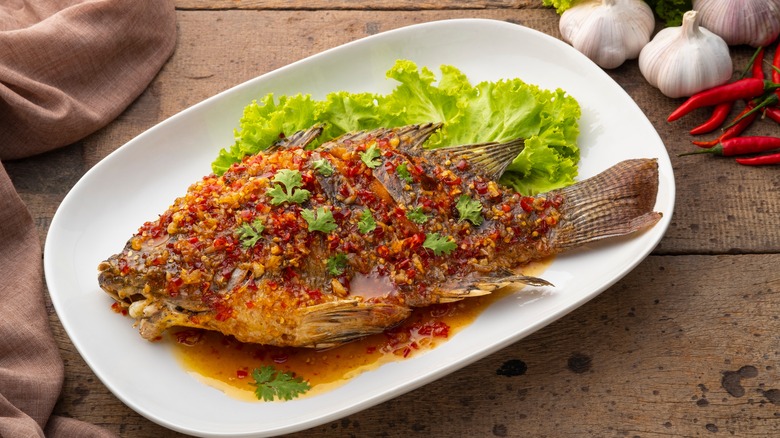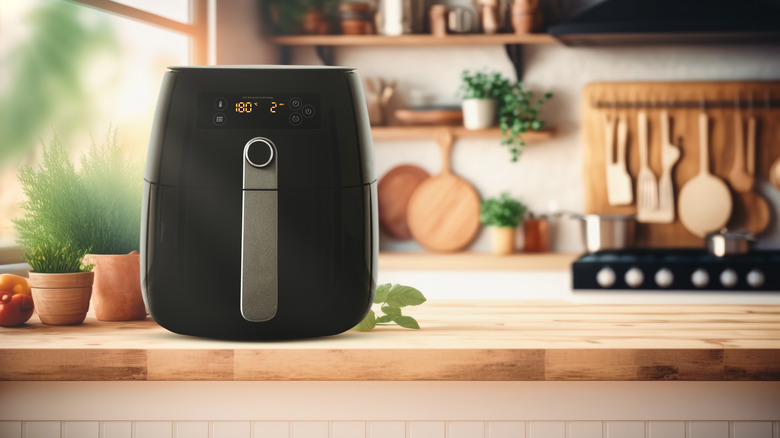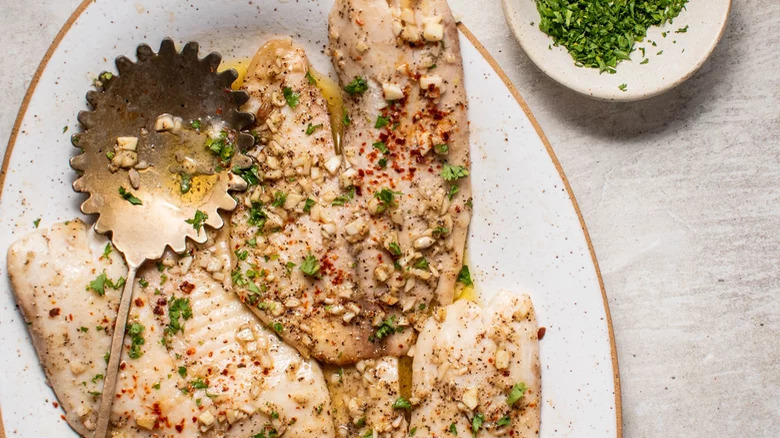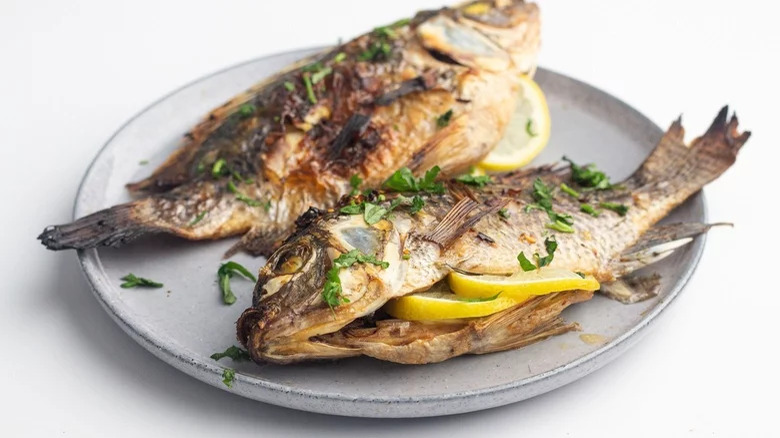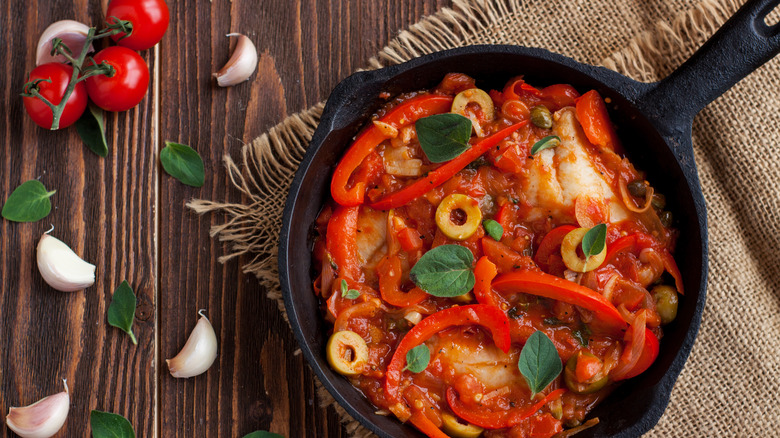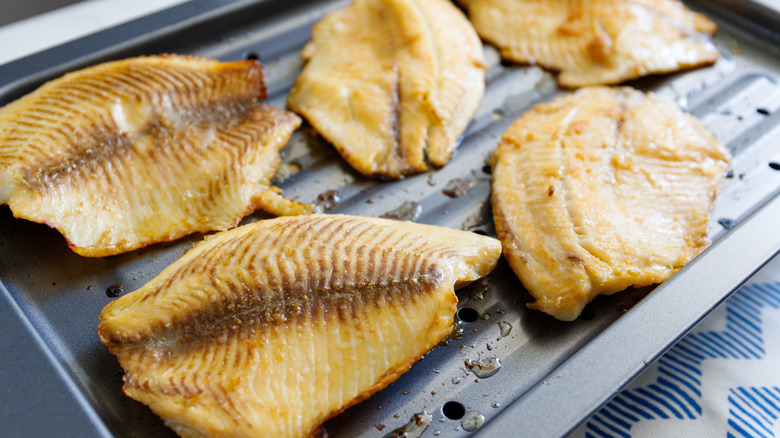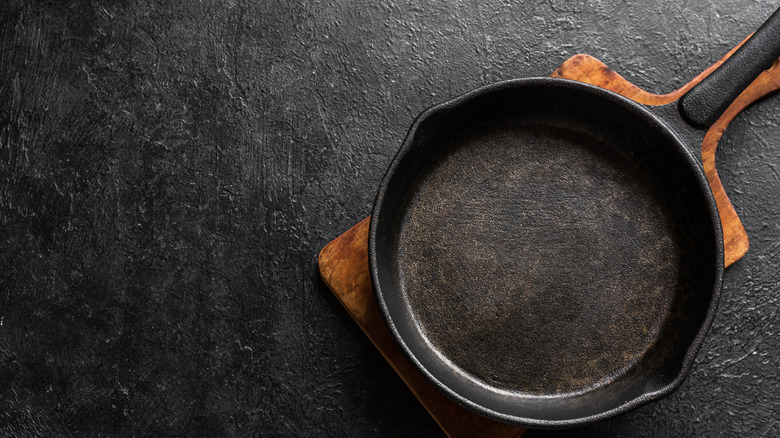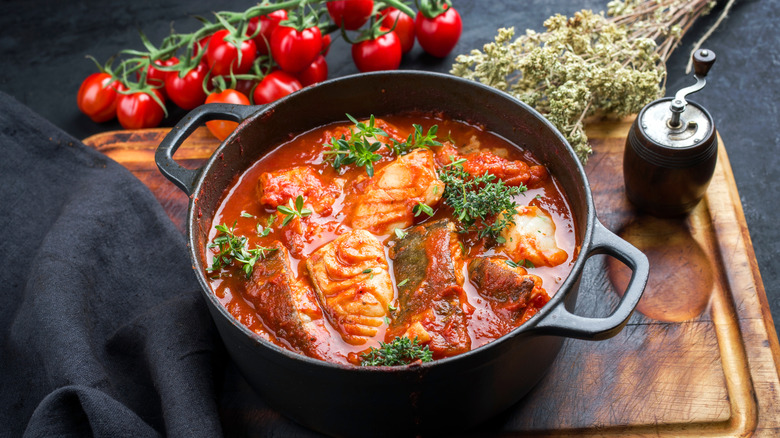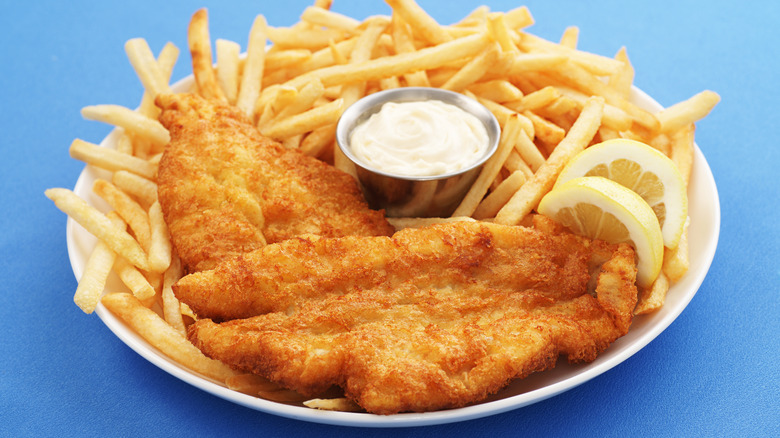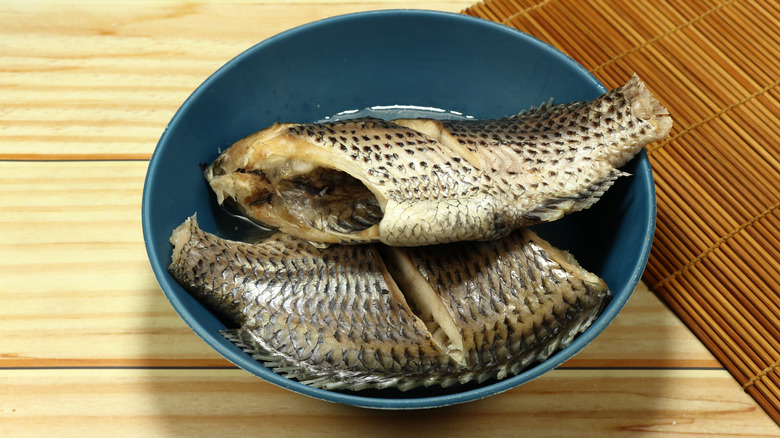The Best And Worst Ways To Cook Tilapia
Tilapia certainly doesn't have the best rep, with rumors flying all around the Internet proclaiming tilapia is a toxic frankenfish one should avoid at all costs. Legends of tilapia somehow being engineered in a lab by evil scientists are gross exaggerations: The reality is that tilapia is a natural river fish from Africa and perhaps the first example of a farmed fish, with evidence indicating that Ancient Egyptians were already raising tilapia in ponds as early as 4000 B.C.
Indeed, tilapia lends itself particularly well to aquaculture: Low-maintenance omnivores that cope well with overcrowded conditions, tilapia can be raised quite cheaply. But, it's this reality that has unfortunately led to many inhumane and unsustainable farming practices around the world and thus led, in part, to its bad rep.
Luckily, this isn't the case for all tilapia production. At its best, tilapia can be an inexpensive, environmentally sustainable option. Given its low caloric load, and richness in protein, it's a good option for home cooks trying to introduce more fish to their dinner tables.
That said, tilapia doesn't take well to all means of preparation. Some cooking methods will bring out the best in this delicate fish, and others will have you jumping on the tilapia hatred bandwagon. If you want to give tilapia its best shot at being a crowd-pleaser, here are the best cooking methods; steer clear of the latter methods if you know what's good for you!
Best: In a rich, creamy sauce
Tilapia has a fairly mild flavor, which makes rich, creamy sauce the perfect pairing. Creamier sauces bring fat to the party — since more fat often means more flavor, it can transform a simple tilapia fillet into a full meal.
You can easily make a simple pan sauce with tilapia by searing the seasoned tilapia in a pan, taking care not to overcook it. Set the tilapia aside and keep it warm while you deglaze the pan to bring up the flavorful fond and add seasonings and cream. The reduced sauce will coat the tilapia wonderfully and be particularly happy with a side of starchy rice, potatoes, or bread to sop up any extras. But, a pan sauce isn't the only way tilapia can shine with a creamier addition. Dipping sauces ranging from classic béarnaise with tarragon to garlic aioli can be served on the side and added to the plate at the diner's discretion to lend more flavor and flair to the finished dish.
Best: With loads of spice
Much like tofu or chicken breasts, it can be interesting to think of tilapia as a culinary blank canvas. It stands up well to flavorful spice blends like Bangladeshi maach bhaaja with turmeric, cumin paprika, garlic, ginger, pepper, and lime or Cajun blackening spice, which includes smoked paprika, garlic, onion, black pepper, oregano, thyme, and cayenne for heat. You can even transform tilapia into a lovely, Thai-inspired fish curry with coconut milk and fish sauce, as well as another Thai dish, sweet-and-sour pla rad prik.
That said, remember that the secret to success with recipes like these is to think of a sauce or topping for tilapia that will give it loads of flavor without requiring a long cooking time. Rather than simmer tilapia low and slow in a curry, consider making the curry and tilapia separately and topping the fish with the sauce at the last minute. An even quicker approach is to cook tilapia simply and top it with your favorite spiced condiment. Quickly seared or steamed tilapia fillets will be particularly happy, for example, on a bed of rice alongside your favorite chili crisp or in fish tacos with spicy salsa rosa.
Best: In the air fryer
Lean fish like tilapia can be easy to overcook, but the air fryer makes it totally foolproof. Despite its name, an air fryer is basically just a convection oven, capitalizing not on hot oil as a traditional fryer does but on the power of a fan that circulates hot air. The dry, ripping-hot heat manages to cook the food until crispy on the outside and tender within. It takes a mere seven to eight minutes in the air fryer for tilapia to be tender and flaky with a nice browned exterior. Perhaps best of all, an air fryer does away with the pesky problem of a fishy smell wafting through your kitchen from an open pan on the range.
While the tilapia cooks, you've got just enough time to stir together a simple sauce to serve alongside it. Lemon-garlic butter is a great baseline, but you can also infuse butter with herbs, spices, and more.
Best: Baked
Even if you don't have an air fryer, there is a way that you can cook tilapia so that it doesn't stink up your kitchen. Baked tilapia may take a touch longer to prepare than air-fried tilapia, but it's just as easy and it's nearly as quick.
When baking tilapia, there are a few precautions you can take to ensure that it doesn't dry out as it cooks. Brushing tilapia with butter before baking suffuses the fish with moisture, and seeing as you can infuse the butter with herbs, seasonings, and more, it's a great way to add extra flavor. When it emerges, simply top it with the garnishes of your choice and serve!
In the 12 minutes the tilapia bakes, you've got just enough time to prepare the perfect simple side. Blanched seasonal veggies like broccoli and green beans go very well with baked tilapia, and a side of quick-cooking rice pilaf is a lovely vehicle to soak up all that lovely sauce. Or, take advantage of the oven's heat to bake up some quick, cheesy garlic bread to serve alongside the tender fish.
Best: Grilled whole
While tilapia is often sold in fillets, the whole fish makes a particularly impressive centerpiece if you can track it down. Seeing as it doesn't have nearly as many delicate pinbones as some other similar white fish, baked whole tilapia is even easier to enjoy than many of its cousins.
While many fishmongers that sell the whole fish do the dirty work for you by removing any guts and scales, Susan Olayinka offers tips on how to do this at home in her recipe for grilled whole tilapia. Her simple, flavorful recipe sees the fish stuffed with aromatic lemon, green onions, and fresh dill before being seared on the piping hot grill.
To make your life even easier, this grilled tilapia recipe can be served alongside grilled veggies like these grilled veggie kabobs. Finish things off with some grilled garlic bread and you've made an entire dinner without so much as turning on the oven.
Best: In a quick-cooked stew
Most lean fish are easy to overcook, but tilapia is surprisingly an outlier among its white-fleshed friends. While rumors that tilapia is completely impossible to overcook are sadly overzealous, tilapia is indeed far more forgiving of slight overcooking than its cousins. It's one of the reasons why it works so well in quick stews that pair it, for instance, with fennel and a spicy broth or coconut milk and spices as in a Thai curry–spiced coconut broth.
A quick-cooking tilapia stew is a cinch to pull together even on a weeknight — a boon seeing as this dish is best prepared fresh and eaten the day of to avoid drying out the tilapia. If you do end up with any leftovers, you'll need to be especially careful not to overcook the fish when reheating. Cover the stew and heat it gently over medium-low heat to ensure that the tilapia warms through without drying out.
Best: Broiled
Broiling lean fish like tilapia is a no-brainer to render the fish flaky and tender inside while still retaining a wonderfully crispy skin. Given the high heat of the broiler, the tilapia is able to caramelize and brown without drying out, bringing out the fish's natural sweetness.
You can help magnify this sweetness even more by marinating the tilapia, which will have the added bonus of adding even more moisture to the fish. Choosing a marinade with a touch of sugar, whether in the form of fruit juice like orange juice, sweet sauces like mirin or sweet soy sauce, or simple cane sugar dissolved into the liquid ingredients, will bring out even more of these sweet flavors. Consider teriyaki-glazed tilapia, which can pair perfectly with simple, steamed green beans or broccoli tossed with sesame oil and sesame seeds. A side of steamed white rice is the perfect foil for all that lovely flavor.
Worst: Grilled skinless fillets
Whole tilapia is very happy on the grill, thanks to the skin and bones that help preserve its moisture and provide a barrier between the tender fish and the high heat. But tilapia fillets, on the contrary, are anything but. Flaky fish is a bit of a nightmare to cook on the grill as it has a tendency to stick to the grates and fall apart when you attempt to flip it. While these issues can be offset by using skin-on fillets, skinless fillets and the grill are far from friends.
If you're dead set on grilling skinless tilapia fillets, there are a few ways you can attempt to diminish the likelihood that your fish will fall apart. Be sure your grill is very clean and well-greased before adding the fish, and be sure to flip it super early in the cooking process to ensure it isn't sticking. You could also consider using a cedar plank to cook your tilapia fillets, although be forewarned: While this method works well for strong-flavored fish like salmon, the delicacy of tilapia may be overwhelmed by the smokiness of the wood.
Worst: In cast iron
Cast iron is a wonderful means of cooking anything from steak to chicken to cornbread. Cast iron at its best is naturally nonstick, but more often than not, tilapia will stick to even the best-seasoned cast iron skillets. This paves the way for a similar nightmare as if you were to attempt to grill the fish.
In the case of tilapia, cast iron's most essential strength is transformed into its biggest weakness. Cast iron is an amazing heat conductor that gets — and remains — ripping hot for the duration of the cooking process. The delicate flakiness of tilapia is unfortunately no match for such a hot pan, and the fish will usually fall apart.
If you want to cook your tilapia in a pan, carbon steel or nonstick are far better options for fish that you want to stay in pretty, whole fillets. If all you've got is cast iron, consider lining it with a sheet of parchment paper first so that you can transfer your fish out of the pan in one, pretty piece.
Worst: Slow cooked
Slow-cooking is the perfect way to tenderize tougher cuts. Over the course of the low, slow process, the collagen and sinew in meats like pork shoulder or beef shin melt into delicious gelatin, resulting in meat that is fork tender and suspended in a richly flavored sauce. When it comes to lean fish like tilapia, slow-cooking is the perfect way to end up with a dry bit of styrofoam.
This is because the muscle fibers of fish are far shorter than in meats like beef. They cook through quickly, and as the collagen holding them together dissolves just as quickly, the fish flakes apart. Almost immediately after, the moisture in the fish begins to evaporate: The fish becomes overcooked and dry. Cooking fish for a short period of time at a high temperature is the ideal way to ensure it remains tender and moist and never overcooks. This holds especially true for thin tilapia fillets, which would overcook in slow-cooking methods like stews and gumbos.
Worst: In fish and chips
Fish and chips is a British staple for good reason: Who wouldn't want to enjoy flaky fish in a crispy beer batter with a side of golden potatoes and tartar sauce? Since this dish most often relies on flaky, white fish like cod, hake, or haddock, it's no surprise that some have been pushing for tilapia to get a spot at the chippy, thanks to its relative sustainability.
The reality is that tilapia is one of the worst contenders for deep-fat frying. The thin fillets are relatively delicate as compared to meatier cod, making them easy to overcook or — worse — giving them the unfortunate tendency to fall apart when battered and fried. Seeing as tilapia cooks through very quickly, it's easy to end up with either overcooked fish or batter that isn't quite as golden brown as you'd like. When it comes to fish and chips, skip the tilapia in favor of more pollack. In addition to being more traditional in fried fish, this cut is frequently fished in a sustainable way.
Worst: In too simple a sauce/with too simple a seasoning
Tilapia is a great option for those who think they don't like the briny flavor of fish for one simple reason: It's relatively mild. But, what's a boon for those easing themselves into the waters of seafood-driven specialties is a major downside for those who love fish's flavor. Indeed, tilapia can prove bland as compared to many other fish, and if you don't give it some help, it's likely to prove a ho-hum dinner offering.
To add insult to injury, as a freshwater fish, tilapia may boast an unpleasant grassiness or muddiness familiar to many who eat river fish, especially if it's prepared too simply. Salmon can happily be seared or poached with just salt and pepper and still sing. Tilapia? Not so much. That said, with a bit of creativity, not only will you disguise any grassy aromas, but you'll also be able to transform tilapia into a host of distinct dishes each more delicious than the next.
